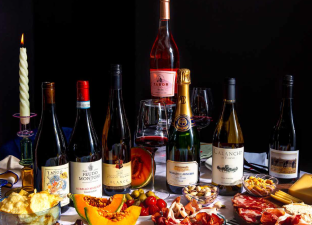Wine Pairing Tips for Non-Experts
With the popularity of wine, it has become a fixture on many home and restaurant tables. However, pairing wine with food still leaves many people perplexed. Which wine pairs best with which food?
With the popularity of wine, it has become a fixture on many home and restaurant tables. However, pairing wine with food still leaves many people perplexed. Which wine pairs best with which food?
Basic Principles
- The effect of food on wine is greater than the effect of wine on food.
- The food comes first, then the wine matches the food. The wine comes first, then the food is ordered.

Wine pairing tips are as follows:
- Similar Tastes
Strong wines with strong flavors, light wines with light flavors (e.g., full-bodied Cabernet Sauvignon with beef, lamb, or smoked meats).
Sour wines with sour flavors, sweet wines with sweet flavors (e.g., acidic Sauvignon Blanc with saltwater fish and lemon juice).
- Complementary Tastes
Sour, bitter, and high-alcohol wines with rich foods (e.g., Champagne or MCC with cheesecake).
Sweet wines with salty flavors, e.g., sweet wine with salty blue cheese).
- Red with red, white with white.
Red wine pairs well with red meats, including Chinese dishes with soy sauce.
White wine pairs well with seafood and white meats.

The golden rule of pairing: balance is key.
Before exploring specific combinations, understand three basic principles to avoid blind pairings:
- Acidity with acidity: High-acid wines (such as Sauvignon Blanc and Sangiovese) can pair well with similarly acidic foods (such as tomato pasta and citrus salad). The acidity acts as a "cleanser," refreshing both and preventing either from appearing bland.
- Tannins with fat: The tannins in red wines (such as Cabernet Sauvignon and Nebbiolo) break down the fat in meats (such as steak and roast duck), while the fat softens the astringency of the tannins, like sandpaper meeting lubricant.
- Sweetness with sweetness: Sweet wines (such as Riesling and Port) should be paired with foods of equal or greater sweetness (such as chocolate cake and blue cheese). If the wine is less sweet than the food, it will appear tart and harsh.
Remember: There's no absolute "wrong" pairing, but following these principles can increase your chances of a delicious meal.

Avoid Pitfalls: These Pairings Are Commonly Misplaced
- Don't pair high-tannin red wines (like Cabernet Sauvignon) with fish: the tannins can impart a metallic flavor to the fish, like biting into rusty iron.
- Don't pair sweet wines with spicy dishes (unless the wine is sufficiently sweet): the spiciness amplifies the wine's astringency, creating a double-edged effect.
- Don't pair rich white wines (like oaked Chardonnay) with steamed fish: they can mask the fish's sweetness, like adding soy sauce to plain water.
The best pairings often come from experimentation—try different wines with the same dish at home and note the combinations that surprise you most.
